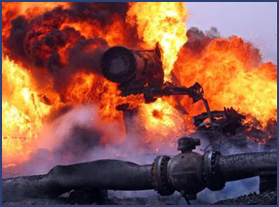Follow The Oil: Identifying The Real Surge In Iraq genre: Just Jihad & Polispeak

I sometimes find it difficult to comment further on the Bush administration's handling of the war in Iraq...its all been said before...and done before. The latest iteration of a troop surge seems little more than an encore of prior attempts to bring some semblance of order to a nation that seemingly isn't ready to sit down and figure out how its various sectarian groups can coexist. Four plus years into the conflict and those in charge are still churning out new rationales for their actions while asking the American public to remain optimistic and to be patient and give them a little more time.
A new report on the benefits of the latest troop surge, compiled by the Pentagon, suggests that the best case scenario is that the added military presence has created a slight decrease in violence. The more likely conclusion is that it has had virtually no impact on the overall statistics and the more important mind set of the combatants.
Newly declassified data show that as additional American troops began streaming into Iraq in March and April, the number of attacks on civilians and security forces there stayed relatively steady or at most declined slightly, in the clearest indication yet that the troop increase could take months to have a widespread impact on security.
Even the suggestion of a slight decline could be misleading, since the figures are purely a measure of how many attacks have taken place, not the death toll of each one. American commanders have conceded that since the start of the troop increase, which the United States calls a “surge," attacks in the form of car bombs with their high death tolls have risen.
As troops continued to arrive, the statistics show, the early effect on countrywide attacks was at best marginal, although there does appear to have been a slight decrease. The daily attack figures for March and April, released yesterday for the first time, were 157 and 149, respectively.
“The improvement is too small to be meaningful, but it’s too soon to declare defeat," said John Pike, director of GlobalSecurity.org, a research group that closely follows the conflict.
The attack data are compiled by the Pentagon but were made public in a report released yesterday by the Government Accountability Office. It analyzed the effect of the attacks on the struggling American-financed reconstruction program in Iraq, especially the program’s failings in the electricity and oil sectors.
Alas, there is one surge happening in Iraq that has caught my attention and that I believe speaks to the real status of this ill-conceived and terribly executed mess we now call the war on terror...it is the surge of oil...in the form of 100,000 to 300,000 barrels a day that have continued to vanish each and every day.
A draft version of the report, obtained by The New York Times last week, indicated that every day during much of the past four years, somewhere between 100,000 and 300,000 barrels of oil, valued at anywhere from $5 million to $15 million, had been unaccounted for. But the draft report did not contain the attack statistics.
“Insurgents have destroyed key oil and electricity infrastructure, threatened workers, compromised the transport of materials, and hindered project completion and repairs by preventing access to work sites," the report says.
The report also contains the analysis of what appears to be billions of dollars of oil that is unaccounted for over the past four years. The report says smuggling, sabotage or colossal accounting errors could potentially account for the discrepancy.
A senior Iraqi official said yesterday that the Iraqi government believed the most likely explanation is a major smuggling effort by Shiite militias in the oil-rich south of Iraq.
Perhaps I'm hopelessly naive, but wouldn't it be safe to conclude that siphoned and smuggled oil money is funding much of the insurgent activity? I realize that when it comes to money, the U.S. frequently operates under the premise that the left hand need not understand the activities of the right hand...but aren't we dealing with far more than routine economics when it comes to Iraq? If I understand the conflict, economics is further fueling resistance to the crafting of an acceptable political solution as the various regions battle for control of oil reserves and the money they will generate.
If the U.S. effort cannot succeed in managing, monitoring, and maintaining Iraq's vast oil resources (the primary source of hope for rebuilding the country), just how do we expect to see an undermanned and poorly trained Iraqi security system do so? Further, unless Iraq can create a viable government that can sustain a functional economy, there simply isn't enough glue to hold the shattered country together.
If, as it seems, oil revenues are fueling the sectarian conflict, the battle to create a functional Iraq is not only a pipe dream...it is a shattered pipeline pouring out the fuel that will forever feed the fires of civil war.
Many months ago, Senator McCain described our efforts in Iraq as being akin to a game of whach-a-mole...a process of constantly shifting troops from region to region in an effort to quell unrest...only to see the conflict pop back up again in each area just after the troops have vacated.
I'll offer a far more ominous analogy...we're literally running out of fingers to plug the leaks in a poorly designed and fully makeshift barrier that is holding back the fuel (literally and figuratively) that has the potential to engulf the entire region in the flames of unfettered futility. If we can't oversee the flow of oil, what hope can there be to extinguish an unchecked and expanding fanaticism?
Post a comment